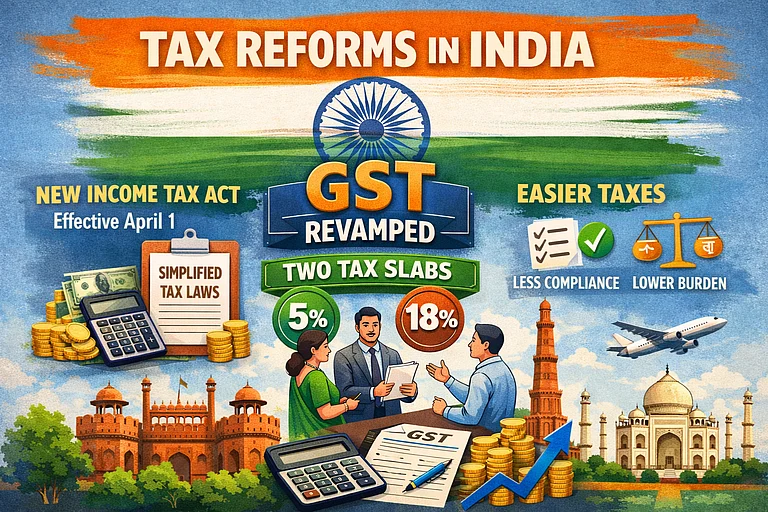
Summary of this article
Rental income in India is taxed under the Income Tax Act, 1961, specifically as "Income from House Property." Tax is calculated based on the Gross Annual Value (GAV), from which municipal taxes, a 30% standard deduction, and home loan interest are deducted. Self-occupied properties up to two are exempt, while others may be taxed even if vacant. Subletting income and commercial rentals may fall under different tax heads. NRIs are taxed similarly but must comply with TDS and DTAA rules. GST applies only to commercial rentals above threshold. Taxpayers can reduce liability using standard deductions, loan interest, and occupancy status.
For property owners in India, tax on rental income is treated under the provisions of the Income Tax Act, 1961, namely, under the head, “Income from House Property”. The same Act says that where the house is self-occupied, it's exempt from tax, and if it's vacant, it depends on other factors, namely the Gross Annual Value (GAV) under the same Act.
The GAV of the property serves as the foundation for tax calculation. From this, deductions such as municipal taxes paid, a standard deduction of 30 per cent, and home loan interest (if applicable) are permitted before arriving at the taxable rental income. Any rent received from sub-letting or commercial rentals involving inseparable services are classified accordingly.
What Qualifies as Income from House Property
Under Section 22 of the Income-tax Act, 1961, rental income is taxable only when three conditions are satisfied: the assessee must own the property, the property must consist of buildings or land attached to them, and it should not be used by the owner for business or professional purposes.
If the property is rented out and is residential, the entire amount of rent is eligible for tax under 'income from house property.' In case of partial self-occupation, only the let-out area attracts taxes. Rental income on sub-letting is not classifiable as income from house property;it is rather classifiable as 'Income from Other Sources.'
Likewise, if the rental is of inseparable assets, such as a furnished theater or an equipment-loaded property, the income may be taxed under 'Profits and Gains from Business or Profession.'
Tax on Vacant or Self-Occupied Houses
This is a commonly asked question among homeowners. According to the updates in the income tax laws in 2025-26, a taxpayer can claim two properties as self-occupied. Such properties will not be subject to tax, even though one of them remains vacant. However, any additional properties, even if unoccupied, are deemed to be 'let out' for taxation purposes. In such cases, their GAV is calculated based on the market rental value.
How is GAV Calculated
The GAV is either the actual rent received or the fair market value, whichever is higher. Once GAV is known, property tax paid is deducted to arrive at the Net Annual Value (NAV).
For example, if the monthly rent is Rs 25,000, the GAV becomes Rs 3 lakh annually. Deducting municipal taxes of Rs 20,000, the NAV becomes Rs 2.80 lakh. A 30 per cent standard deduction under Section 24A brings this to Rs 1.96 lakh. If there is an ongoing home loan, interest of up to the full amount paid (say, Rs 80,000) is deductible under Section 24B. This results in a final taxable income of Rs 1.16 lakh.
Taxation for NRIs on Rental Income in India
Non-residents who earn rental income from properties in India are taxed under the same provisions as residents. The tenant, in such cases, must deduct tax at source (TDS) before transferring the rent. After that, the tenant has to submit form 15CA to Income Tax Department. Non-residents should check for a Double Taxation Avoidance Agreement (DTAA) in his or her country of residence in order to avoid double taxation.
GST on Rental Income
GST is not charged on rental income from housing properties. But if a property is rented out for business purposes, an 18 per cent GST is charged in case of rental income above the annual limit.
Saving Tax on Rental Income
There are three primary ways for this
30 per cent Standard Deduction: Irrespective of the expenses borne, a flat 30 per cent of NAV can be deducted.
Home Loan Interest: Entire interest paid on a loan for a let-out property can be claimed as deduction.
Claiming Property as Self-Occupied: If owning multiple houses, two can be declared as self-occupied to avoid notional rent tax. In addition, unrealised rent or loss due to vacancy can also be adjusted in GAV computation.
Properties Exempt from this Taxation
Properties owned by trade unions, political parties, or institutions established for promoting the interests of Scheduled Castes, Scheduled Tribes, or minorities are exempt from tax. So are buildings used for charitable purposes or owned by cooperative societies operating under similar aims.
Farmhouses classified under agricultural income and property owned by the government or statutory bodies are also exempt under various sections.
















